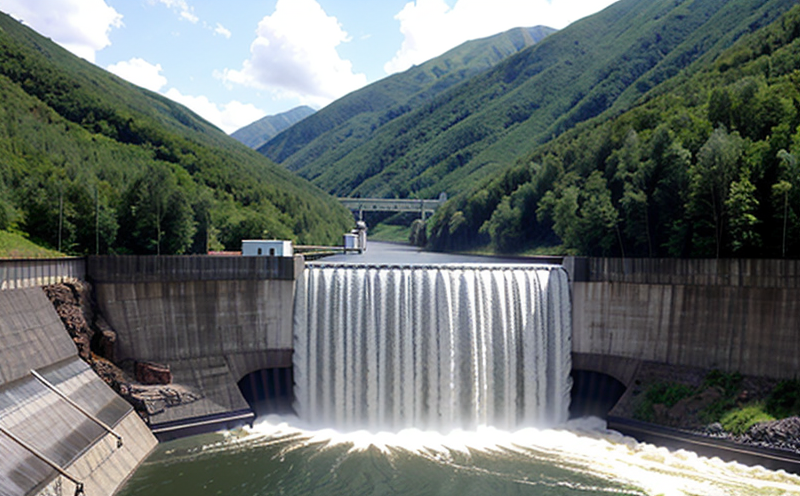ASTM C39 Compressive Testing of Structural Concrete in Hydropower Plants
The ASTM C39 compressive testing method is a critical element in ensuring the structural integrity and longevity of concrete components within hydropower plants. This test evaluates the strength of structural concrete by measuring its resistance to compression, which is essential for assessing its suitability in high-stress environments such as those found in dams, turbines, and other hydropower structures.
Compressive testing plays a pivotal role in confirming that the concrete used meets the stringent requirements set forth by international standards. For instance, ISO 23176 provides guidelines on the production of structural concrete for hydraulic structures, emphasizing the importance of proper material selection and quality control throughout the construction process. ASTM C39 is particularly relevant when dealing with large-scale projects where even minor deviations in strength can have significant impacts on operational safety and cost.
The testing procedure involves preparing standard cylinders or prisms that are identical to those used during the mixing process, allowing for a direct comparison of the laboratory results against the design specifications. The specimens are then subjected to controlled compression until failure occurs, at which point their maximum compressive strength is determined. This value is crucial for assessing whether the concrete can withstand the pressures and stresses it will encounter in its operational environment.
Understanding the specific requirements of ASTM C39 involves not just the mechanical properties but also the chemical composition and physical characteristics of the concrete mix. For example, the choice of aggregate size, type, and grading significantly influences the test results and ultimately the structural performance. Additionally, proper curing conditions must be maintained to ensure that the concrete reaches its full strength potential before testing.
The significance of ASTM C39 in hydropower plant construction cannot be overstated, as it directly impacts the reliability and safety of these facilities. Hydropower plants are subject to extreme environmental conditions, including high water pressure, temperature fluctuations, and mechanical stresses from rotating machinery. Ensuring that the structural concrete used can withstand these challenges is paramount.
The test results not only inform decisions about material selection but also guide quality control processes throughout construction. By adhering to ASTM C39 standards, hydropower project teams can achieve consistency in material performance, which translates into safer and more efficient plant operations. The reliability of the compressive strength data obtained through this testing method is critical for long-term facility maintenance and safety audits.
Furthermore, the use of ASTM C39 in hydropower plants aligns with broader industry best practices aimed at enhancing structural integrity and sustainability. By incorporating rigorous quality control measures like this test into their processes, hydropower operators contribute to the overall resilience of infrastructure against natural disasters and operational wear-and-tear.
Why It Matters
The importance of ASTM C39 testing in hydropower plants cannot be overstated. The integrity of structural concrete is paramount for maintaining the safety, efficiency, and longevity of these facilities. Accurate compressive strength data ensures that the materials used can withstand the high-pressure environments typical of dam systems, turbine units, and other components.
- Material Selection: Ensuring proper selection of aggregates and cement types to meet design specifications
- Quality Control: Consistent monitoring of concrete quality throughout the construction process
- Safety Assurance: Reliable data for safety audits and operational reliability assessments
The accuracy and consistency of ASTM C39 testing contribute significantly to reducing risks associated with structural failure, which could lead to accidents or costly repairs. By adhering to these standards, hydropower operators can enhance the overall performance and sustainability of their facilities.
Customer Impact and Satisfaction
- Increased Safety: Reduced risk of structural failure due to verified concrete strength
- Economic Benefits: Lower maintenance costs through durable construction materials
The implementation of ASTM C39 testing has a direct positive impact on customer satisfaction in the hydropower sector. By ensuring that all components meet or exceed the required standards, operators can provide reliable and safe energy production facilities. This not only enhances operational efficiency but also builds trust with stakeholders and regulators.
Customers, including regulatory bodies, quality managers, and R&D engineers, can rely on the comprehensive data provided by ASTM C39 testing to make informed decisions about material selection and construction practices. The consistent adherence to these standards ensures that hydropower plants are built to last, thereby reducing the need for frequent renovations or replacements.
Moreover, the use of ASTM C39 in testing concrete strength supports sustainability goals by promoting the use of durable materials that can withstand harsh environmental conditions. This results in longer-lasting infrastructure, which is particularly beneficial given the long operational life spans of hydropower plants.
Environmental and Sustainability Contributions
The ASTM C39 testing method contributes positively to environmental sustainability by ensuring that structural concrete used in hydropower plants meets stringent quality standards. This not only enhances the durability of these facilities but also reduces the carbon footprint associated with frequent maintenance or replacement.
- Reduced Emissions: Longer-lasting infrastructure means fewer disruptions and reduced emissions from construction activities
- Resource Efficiency: Properly selected materials minimize waste during installation and reduce resource consumption over time
The use of ASTM C39 in testing ensures that the concrete used is robust enough to handle the specific demands placed on hydropower plants. This reduces the likelihood of structural failures, which would require additional resources for repair or replacement. By promoting the use of high-quality materials through rigorous testing, this service supports broader sustainability efforts within the industry.
Additionally, the accurate data provided by ASTM C39 helps in optimizing material usage and design, further contributing to resource efficiency. Hydropower operators can leverage these insights to implement more sustainable practices that align with global environmental goals while maintaining high operational standards.





